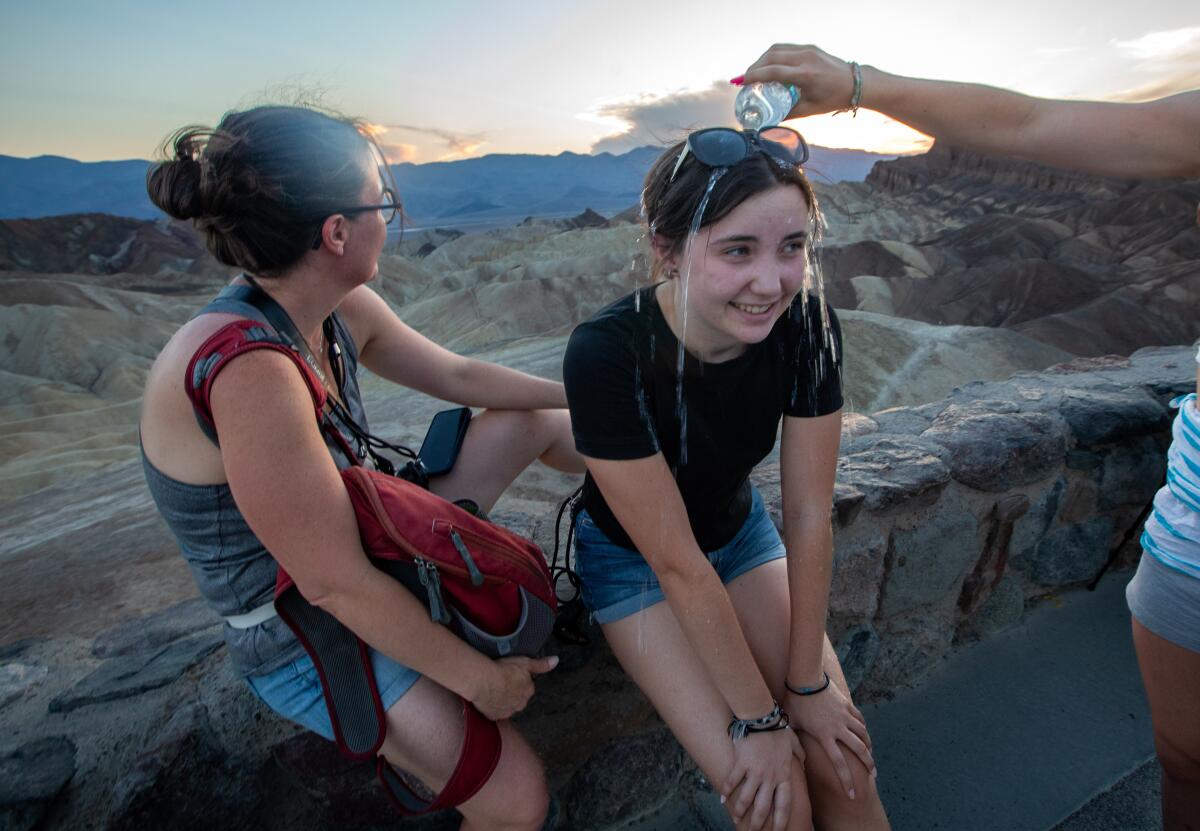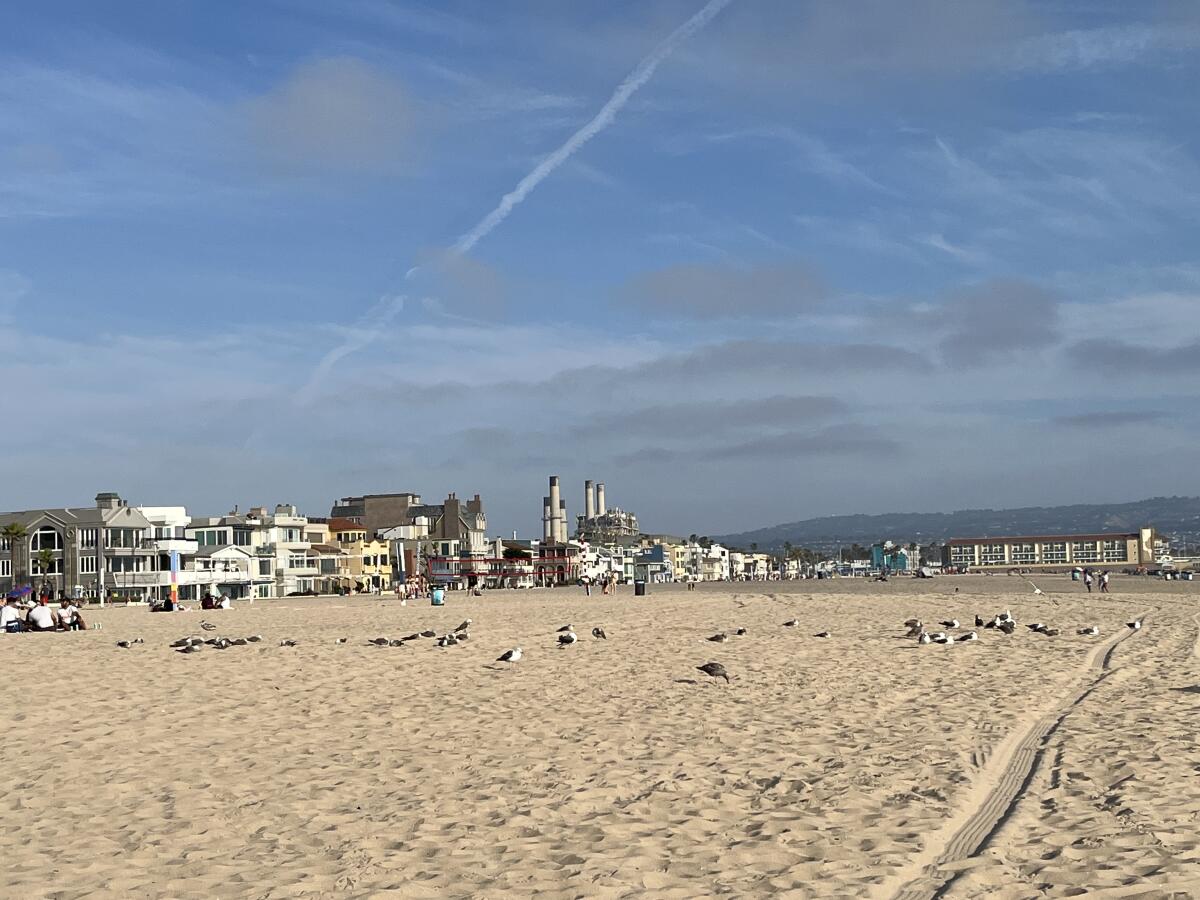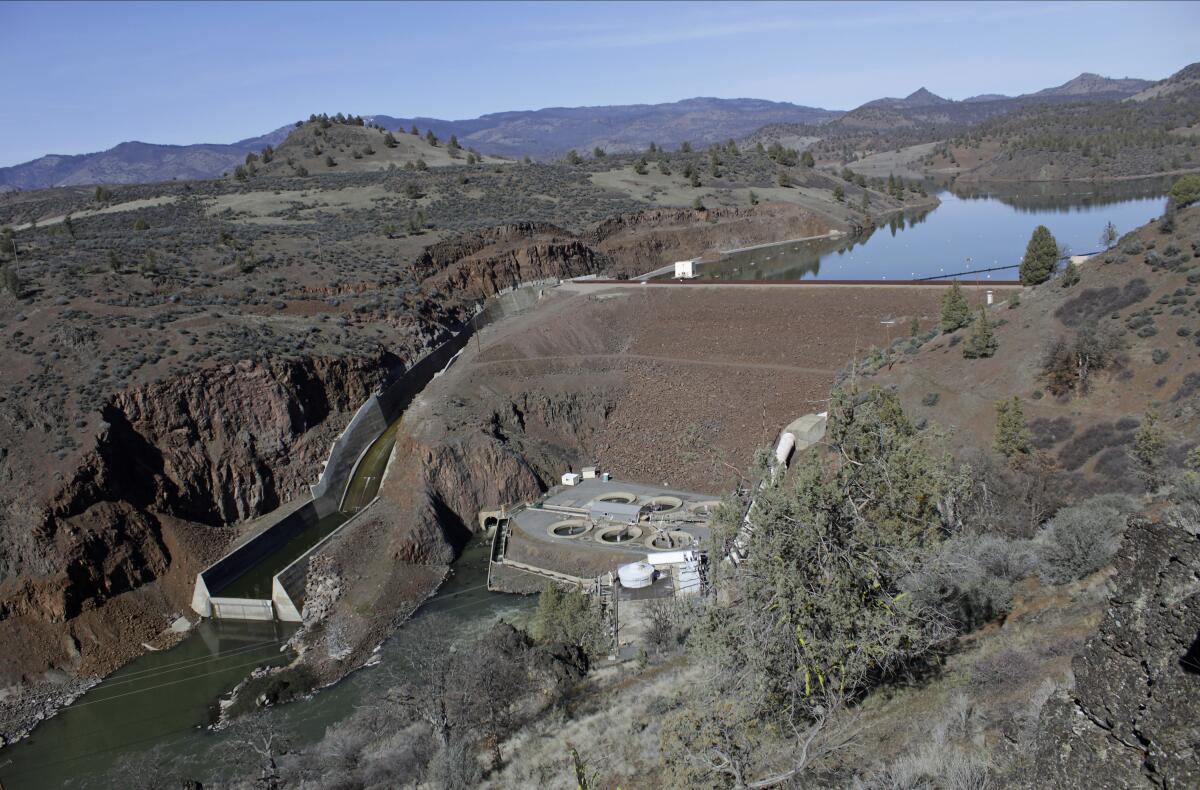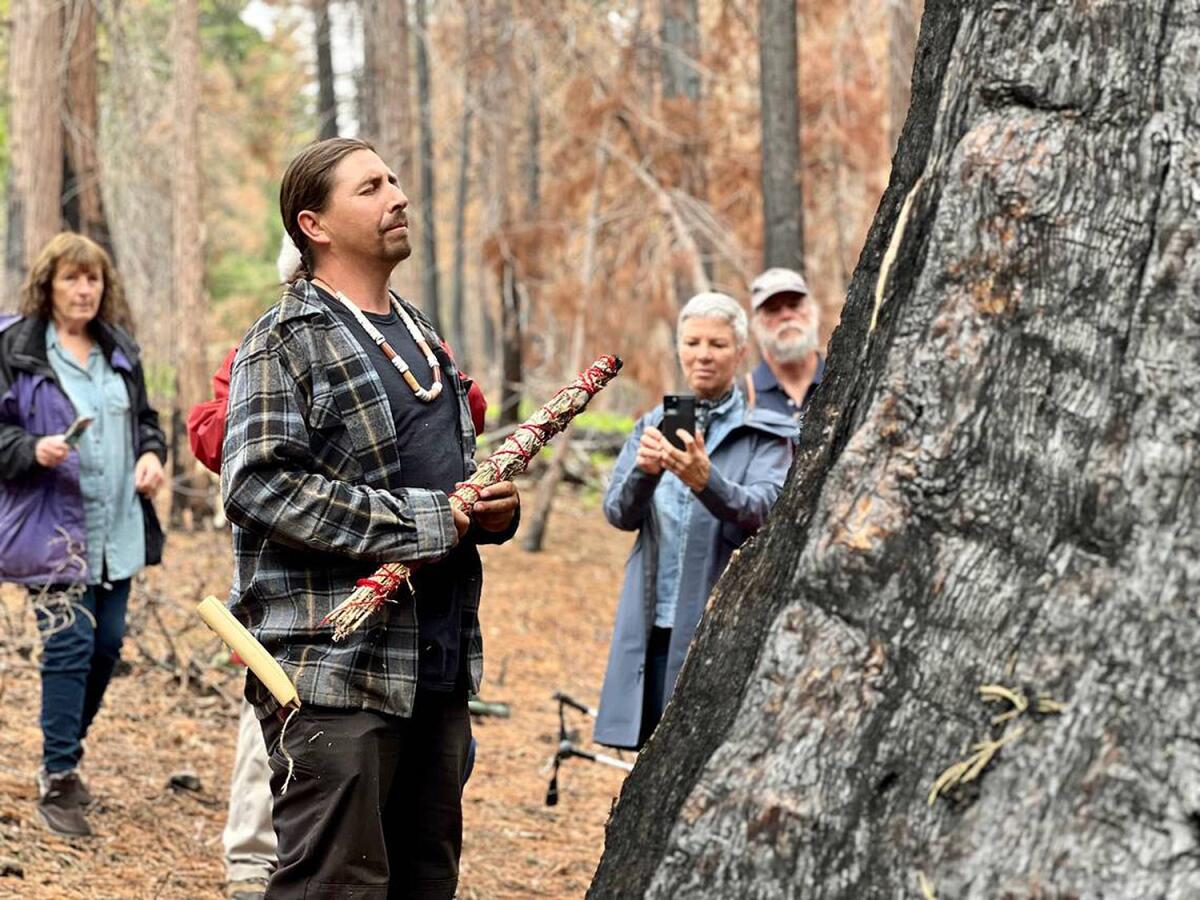Boiling Point: This heat is not normal

- Share via
This story was originally published in Boiling Point, a newsletter about climate change and the environment. Sign up here to get it in your inbox.
Yes, it’s been toasty before. But not like this.
Earth just endured its hottest June on record — by a lot. And at least in California, July has been hotter. Death Valley National Park topped out at 128 degrees on Sunday, The Times’ Hayley Smith reports, and only cooled to 120 degrees by midnight.
This is what climate change looks like. And it’s not just heat, of course. With brutal temperatures, unprecedented ocean warming and wildfire smoke engulfing major cities, Americans may feel as though they’re auditioning for the climate disaster film “The Day After Tomorrow,” my colleague Jenny Jarvie writes.
“I’d say this is unbelievable, but that word has been losing its meaning lately,” one scientist told Jarvie.
We need to cut down on fossil fuel combustion and reduce heat-trapping pollution, quickly. We also need to find ways to live with the changes already underway in our planet’s atmosphere — and stay sane while doing so.
Some of the worst consequences are being felt by farmhands and other outdoor workers with no choice but to keep laboring under the merciless sun. People without a roof over their heads are suffering, too, as are families without air conditioning. My colleagues Rachel Uranga, Priscella Vega and Paloma Esquivel wrote about what it’s been like for some of those folks, starting with grape pickers sleeping under a bridge in the Coachella Valley.
Also check out this story by my colleagues Suhauna Hussain, Emerson Drewes and Jen Yamato, about Southern California’s “hot labor summer” as striking Hollywood writers and actors, hotel staff, delivery truck drivers and fast-food employees picket in the dangerous heat, demanding fair wages and working conditions — including, in some cases, cooler indoor temperatures.
“Nothing will deter me from coming out to strike,” TV writer and producer Rachel Lewis said.
I was at a coffee shop across the street from the Sony Pictures lot in Culver City on Monday, watching picketing writers walk past and wondering how long they could stand the heat (and hoping they’d incorporate climate and clean energy into their TV shows and films). A few days earlier I was at the beach, looking just down the coast at the Redondo Beach gas plant and wondering how much fossil-fueled power it might have to churn out this week to help keep the region’s air conditioners running.

For Angelenos who need an A/C unit but may not be able to afford it, the city’s Department of Water and Power is offering big rebates, as The Times’ Jon Healey explains here. If air conditioning isn’t in the cards, here are some tips for staying cool without it, via my colleague Jessica Roy.
Officials working for California Gov. Gavin Newsom, meanwhile, are launching a statewide campaign to warn people to protect themselves against extreme heat — but there’s still a lot more they could be doing, Hayley Smith writes.
Global warming can feel all-consuming, overwhelming, impossible to do anything about. My best advice is to stay cool, stay informed and stay focused on your own small contribution to solving the problem — whether that’s consuming less energy, putting solar panels on your roof or pushing your elected officials to enact badly needed systemic change.
On that note, here’s what’s happening around the West:
THE ENERGY TRANSITION

California’s got a new law designed to protect Joshua trees from housing construction, renewable energy development and climate change, after state regulators deadlocked on an Endangered Species Act listing. Details here from The Times’ Louis Sahagún, who has spent several years covering the conflict between conservation and clean energy in Joshua-tree habitat. In another example of that conflict in Nevada, the Biden administration is working to protect an endangered toad species by reevaluating its approval of a geothermal project that could potentially supply climate-friendly electricity to California, Jeniffer Solis reports for the Nevada Current. For more context on geothermal energy and the debate over this particular project, see my story from earlier this year.
Lithium Americas is suing some of the people who have protested at its Thacker Pass mine site in Nevada, saying they have blocked roads, vandalized equipment and otherwise disrupted construction. Protesters say the company is trying to intimidate them and silence their free speech, the Nevada Independent’s Amy Alonzo reports. Yes, this is another climate vs. conservation conflict, because lithium is used to make electric vehicle batteries and energy storage systems. In another Nevada lithium battle, the Las Vegas Review-Journal’s Colton Lochhead reports that the Biden administration has paused exploratory lithium drilling outside Ash Meadows National Wildlife Refuge and will conduct an environmental review.
Also in Nevada, the proposed Greenlink electric line would bring more solar power from the desert to Las Vegas, reducing fossil fuel combustion. But should the line be allowed to cross through a small part of a national monument? The Review-Journal’s Sean Hemmersmeier wrote about how Greenlink might affect Tule Springs Fossil Beds National Monument. Not having visited Tule Springs myself, it’s hard for me to say what the right answer is. But I’m reminded of what I wrote last month about renewable energy infrastructure, and the difficulty of finding low-conflict places to build it: “The sad truth is, not everything can be saved. Not if we want to keep the world livable for people and animals alike.”
WATER IN THE WEST

It’s not surprising that climate-fueled drought in recent years led to reduced hydropower production in the West — and as a result, more pollution from coal- and gas-fired power plants. But the magnitude of the difference was startling, Grist’s Jake Bittle writes in a story exploring an important new study. Also important: a body of research suggesting reservoirs behind hydropower dams release large amounts of methane, a planet-warming gas. Hydroelectric dams are still almost certainly better than fossil fuels from a climate perspective, but we shouldn’t ignore their climate effects, as Kristoffer Tigue writes for Inside Climate News. In Northern California, meanwhile, the nation’s largest dam removal project is underway — and one Native American tribe, while supportive, worries the project could do further damage to its ancestral lands and cultural sites. Here’s the interesting story from Kurtis Alexander at the San Francisco Chronicle.
“With climate change intensifying the extreme weather whiplash of severe fires and heavy rains, Southern California is primed to experience landslides more frequently, U.S. Geological Survey researchers found in a recent study.” So writes my colleague Ryan Fonseca, in a recent edition of our daily Essential California newsletter focused on the ongoing landslide wreaking destruction and forcing people to flee their coastal homes in Rolling Hills Estates. Landslide, floods, fires, earthquakes, sea level rise — in the Golden State in the climate era, you’ve almost got to pick your poison, The Times’ Jack Flemming writes.
California officials have proposed regulations that would allow Los Angeles and other cities to pipe purified sewage water directly to our taps. This is a big deal for reliable water supplies as climate change dries up rivers, LAist’s Erin Stone reports. And if drinking recycled sewage water sounds gross to you, please know that it’s proven to be safe — and it’s not like our tap water right now is perfect, anyway. My colleague Dorany Pineda wrote about new research finding that if you live in Southern or Central California, you’re more likely than the average American to be drinking water laced with forever chemicals. Plastics are a problem, too. Another new study examined 38 lakes and reservoirs across 23 countries and found Lake Tahoe had the third-highest level of microplastics. Lake Tahoe tourism may have something to do with it, Cari Spencer reports for The Times.
THE ENERGY TRANSITION
A company wants to build a hydrogen pipeline across the Navajo Nation — but would it be a boon or a boondoggle for a tribe still burdened by decades of fossil fuel and uranium pollution? Capital & Main’s Jerry Redfern wrote about the debate, which is one many such debates happening across the U.S. as the Biden administration rolls out billions of dollars for hydrogen as a climate solution, to the frustration of some environmentalists who see the fuel as a false idol. Intriguingly, the company with the Navajo Nation pipeline plan is working with lobbyists at HBW Resources — a consulting firm that I wrote about in 2020, when it was running a fossil fuel industry-backed advocacy group promoting gas extraction on Native American lands.
Oregon activists discovered that the state’s second-largest gas company is using ratepayer funds to fight climate rules — and the company is defending those expenditures. Here’s the story from the Oregonian’s Alex Baumhardt, who quotes an Avista executive describing the company’s spending as “a prudent expenditure on behalf of our customers” because the climate program in question “negatively impacts our customers through reduced energy choice, higher costs and decreased reliability.” I was especially interested to read that response given my previous coverage of Southern California Gas Co., which responded to similar allegations by agreeing to charge certain pro-gas advocacy work to shareholders instead of customers.
A new study concludes that burning natural gas is just as bad for the climate as burning coal, unless methane leaks are virtually eliminated. The New York Times’ Hiroko Tabuchi wrote about the research, which adds to a robust body of evidence that merely replacing coal with gas won’t avert disaster (although it would result in less lung-damaging air pollution, as Tabuchi notes in her story). Ultimately, we need zero-emission technologies — on the electric grid and also at particular sites that rely on diesel generators. Canary Media’s Jeff St. John wrote about the startups and established companies trying to solve the remaining obstacles for mobile batteries on film sets and elsewhere — some with financial support from Disney and Netflix.
POLITICAL CLIMATE

A controlled burn in California’s Calaveras Big Trees State Park severely damaged two giant sequoias known as “the Orphans” — a blow to the confidence of nearby residents that state officials can conduct controlled burns safely. Most scientists say controlled burns are a crucial tool for limiting the risk of out-of-control fires. But failures like the one at Big Trees undermine public support — and understandably so, as my colleague Alex Wigglesworth explores in her story. In other fire news, California now has high-tech helicopters that can battle flames all night long, The Times’ Hayley Smith reports. And in Oregon, a tiny timber town long past its logging heyday has bought hundreds of acres of surrounding forest in hopes of reducing wildfire risk and drawing in tourists by thinning and protecting those trees, Grant Stringer writes for Inside Climate News.
After electing a Republican governor, Nevada is ditching the U.S. Climate Alliance — and after electing a Democrat to the governor’s office, Arizona is joining it. Details here and here, respectively, from the Nevada Independent’s Amy Alonzo and the Arizona Republic’s Allie Feinberg. Members of the alliance are committed to cutting carbon emissions in half by 2030, in hopes of keeping global temperature increases to no more than 1.5 degrees Celsius. The shifts in Nevada and Arizona are the latest sign that one major political party is a lot more interested in addressing the climate crisis than the other. For more evidence, look to Michigan, where Democrats recently took control of all three branches of government. As a result, Michigan could soon become the first state to target 100% clean electricity by 2035 — a decade ahead of California, and in line with the Biden administration’s goal, as Canary Media’s Julian Spector notes.
Six years after President Obama established Mojave Trails National Monument in the California desert, federal officials may soon ban a beloved century-old pastime — rock collecting. The Times’ Louis Sahagún and Irfan Khan ventured out before dawn with dedicated rockhounds to see them in action and hear their case for continued collecting in the national monument — a case supported by prominent conservation groups. Elsewhere in the desert, at Death Valley National Park, Sahagún wrote about the latest in a string of unsolved wild burro massacres in California and Nevada.
ONE MORE THING
There’s a long history of oil companies opposing policies and technologies that would limit their profits.
But I was still a bit awestruck by this new Exxon Mobil advertisement taking direct aim at electric cars. The ad shows a series of frustrated-looking people literally bogged down by electric cables, before switching to a shot of two happy-looking individuals — seemingly a mother and her daughter — cruising down an open road toward a scenic mountain vista, cable-free.
The tagline: “Disconnecting. Feels a lot like breaking free. For the love of driving.”
Thanks very much to journalist Amy Westervelt, who hosts the climate podcast Drilled, for flagging.
We’ll be back in your inbox Thursday. To view this newsletter in your Web browser, click here. And for more climate and environment news, follow @Sammy_Roth on Twitter.
Toward a more sustainable California
Get Boiling Point, our newsletter exploring climate change, energy and the environment, and become part of the conversation — and the solution.
You may occasionally receive promotional content from the Los Angeles Times.






